#Edo period
Explore tagged Tumblr posts
Text

Naruto Uzumaki [Naruto] by TsuyaNoUchi
https://tsuyanouchi.etsy.com
#naruto art#naruto fanart#naruto#naruto series#naruto shippuden#naruto au#sasuke uchiha#fanart#manga#anime#naruto uzumaki#boruto uzumaki#leaf village#rasengan#jutsu#sexy jutsu#shadow clone jutsu#uchiha itachi#anime art#anime fanart#japanese art#anime and manga#edo period#ukiyoe#tsuyanouchi
156 notes
·
View notes
Text
In Your Language…How Can I Reach You? Act I Pt II


Samurai lord! Itoshi Rin x Polyglot! Fem! Reader
———————————————————————————-
Warnings: Trauma Responses, Angst again, Sae appears antagonistic, toxic sibling dynamics, Reader is tall
(Thanks for all the Love!! Here’s part two! Part three is in the works, this will probably be pretty ongoing. Much love!) - Ro
————————————————————————————
Act I part II: Passing faces, conflicting philosophy
Sae stepped easily out of the rowboat that docked on Edo’s port, clothing fit for a western sailor-boots and all-on his now much thinner form. He dwarfed Rin who dutifully came to greet him, the shadow of grief lifting off of him despite how resentful he still was.
Rin bowed respectfully to Sae, trying his best to look away from the garb he now donned.
“Welcome home, brother…”
He uttered, a twisted feeling burning uncomfortably in his chest and stomach. Sae did the same, though his etiquette was a lot looser from the way they were taught, Rin noticing right away.
“Yes, Itoshi-Dono. Quite a while.”
Sae said politely, sentences lazy and easygoing, heavy like honey.
‘Quite a while’ was an understatement.
Sae moved past him, gravel crunching under his boots. Rin wasn’t far behind, a part of him holding back from chasing after him, the lump in his throat holding the insults he’d dished out to everyone else hostage as he stared at Sae’s back.
A part of him was just happy Sae had returned safely, but he felt stronger about the departure in the first place. And now, Sae was moving on from here, using ‘-Dono’ as if he’d never reclaim his place above him.
“I’m staying at Edo palace,”
Sae began boredly, directing various Portuguese sailors where they needed to go.
His eyes, cold and yet filled with steady fire, like blue-tinted Jade in the sunlight, finally met Rin’s far more fluid gaze.
“I have much to discuss with Tokugawa-Dono.“
————————————————————
Your first meeting with the older Itoshi was for quite a useful task. You perceived him a foreigner since his hair was so outrageous. Your chin raised a little as your eyes sharpened, though your mouth remained pleasant as you spoke. You greeted him and introduced yourself in Spanish, having seen the ship fly a flag you’d seen before.
“My name is Itoshi Sae, formerly Lord Itoshi.”
He explained in Japanese, making your face heat up in embarrassment as you corrected your etiquette.
“A-ah… apologies, Itoshi-San. I was under the impression we shared unfamiliarity with this land. How embarrassing of me,”
Sae simply waved it off, your eyes quickly recognizing the blasé behavior as something the current Lord Itoshi had. Their eyes, though slightly different, both looked incredibly dangerous.
The Shogun had you sit in on the meeting with Sae and his trading partners, having learned one needs an interpreter that’s theirs to ensure what they’re hearing is untwisted by foreign hand.
You listened intently, nodding along when the Shogun’s eyes landed upon you for confirmation, correcting what needed correction, much to Sae’s irritation as you actively caught his mistakes. There was no denying it. You were invaluable. By now, you’ve been seen as a child of the Shogun rather than a consort with the way he enriched your skills through books as gifts. As Lord Tokugawa watched the two of you, he found himself quite amused, a small chuckle leaving him when you’d correct the older Itoshi. An idea was beginning to form for him, one that might prove a bit strenuous on the both of you.
Over the duration of a week, you continued like this, the Shogun finally giving you time to yourself again after at least four days of confirming the right words and annotating mistakes on paper eventually to avoid Sae’s undeniably intense gaze. All the while, you’d noticed that those brothers…really didn’t know how to talk to each other, or anybody else.
As you walked the gardens with your entourage, Tabito in tow as a regular guard and companion for you, your discussions about this and that were interrupted by what appeared to be screaming matches in the new guest wing. It was often in other languages—Spanish being the most common. It wouldn’t go on for too long, however, with a longstanding tradition of a peaceful home being a serious matter in Japan. The subject of it was always Sae, about his tactics being too subtle or other things the Spaniards didn’t understand.
“Being only multilingual in European languages must be challenging,”
You’d mused to Tabito, spectacled eyes trained on a beautiful lotus in the pond you’d grown fond of. What Tabito found was that you could be a bit arrogant now and again, the favor you’d struck with the Shogun spoiling you. This only made him more fond, however, his responses always inflating your ego coyly.
“Ah right, because you know everythin’ eh?”
He’d teased, making you smack him with your sleeve playfully. You’d have become more of an envy in the court if it wasn’t clear how platonic you saw him, your drive to continue learning far exceeding any interest you’d have in anyone besides whatever the Shogun wants. Unfortunately, that tendency had caught up with you as the spring cherry blossoms fell gracefully outside the open door.
////
Rin sat beside his brother with agitation, his skin paler and eyes sticking out even more under heavy bags as if he’d yet to sleep. Sae had his own lowered, a tick in his brow as if deep in thought.
As you entered, you wore Ming fashions, per Lord Tokugawa’s request. Your Aoqun was a precious violet with hand-embroidered songbirds on the bottom of the skirt, the richer purple accentuating your height. You wore a Bijia over to keep yourself from being too cold, the jade color concealing much of your form. Your confusion was evident, wondering why the men you’d watched silently squabbling during the last meeting a few hours before looked as if they were scolded children before him now. Also—why were you being included in it?
As you sat in a proper Seiza near Sae, you bowed respectfully to the Shogun who had a wry smile on his face. As he looked between the three of you, his eyes grew fond.
“Y/N, child. I’ve decided that rather than have you waste away here running childish errands for me, you’d be much happier fulfilling the wishes of any maiden… to be a true wife.”
You raised your head a bit quickly, quirking a brow with all of your confusion sitting plainly on your face.
A…wife?
“Ah-yes. But…aren’t I a consort to you, my lord?”
You inquired slowly, eyes drifting slightly over to the men beside you, their eyes both snapped to attention on the Shogun.
“I cannot bring myself to sully you in such a way, though try that I might. Your purity belongs in a place free from such politics. The love I have for my wife is a fortune in which I believe you, too, should experience with another.”
His gaze is warm and thoughtful, something you felt sorry to leave. Your eyes grow saddened at the change that would befall you, but you knew that your maids would at least keep you company.
“In six months’ time, you shall be betrothed and married into the Itoshi clan. I trust they will care for you as I have, yes?”
He spoke to the brothers as well as yourself, tone firm and final.
The men nodded, Rin albeit reluctantly, unsure of who it was that the Shogun was suggesting, given both their presences here.
“Sae-san, stay. The both of you may take your leave.”
You both bowed and thanked him in unison before exiting on either side of the doorways, one out onto the engawa, where you tread lightly, a cherry blossom falling in your hair as you rejoined your entourage. Tabito plucked the petal off of you as if it was second nature, and a part of you wondered what warmth like this could come from a home like that.
Rin’s opinion was the same, at least self-aware enough to know that much. He was often away, fighting enemies… Neither he nor Sae could possibly be a suitable husband for someone like you- a clear bibliophile with no shred of tactics or ambition in you. He grit his teeth a little, trudging past others in the hallway, irritation lining his stomach.
————————————————————
Sae finally visited Itoshi castle that very evening, donning a kimono and haori to dine amongst his family, the fairly frigid night quiet and somber as he and his brother watched the night scenery. Given Rin’s attitude as of late, Sae was somewhat surprised as he joined him on the stair, the garden’s silence as pensive as the one between them.
His eyes were lost in thought, a strained feeling weighing him down like metal boots in a river. All that flickered in his eyes were the images of the conversation he’d had with the Shogun, his voice lingering in Sae’s ears.
“Sae… are you certain about your decision? She would be of great help to you.”
He’d said, to which Sae replied with great certainty,
“My brother is the more stable choice, my Lord. He is far more worthy of such an honor than I, I’ll promise that.”
He’d bowed low to the floor then, eyes low as his thoughts drifted to the boy he’d left on the cliff that day. He’d much rather make this sacrifice, he reasoned, than the sacrifice of returning here more than necessary on a guilty conscience. At least then, both of them would be taken care of… and Rin wouldn’t have to take on the whole of Japan, as it changed into a melting pot, alone.
“Very well… though, if this is your choice to remain without a consort, you know you cannot stand in Rin’s way as Lord Itoshi. You would no longer make any decisions on the Itoshi clan’s behalf.”
Sae nodded easily.
He knew he would be long gone by then.
He said nothing to his brother for the duration in which he’d been next to him, crickets singing in what felt like a somber tune.
Rin glanced in his brother’s direction, praying for something, anything to escape his lips. Yet, nothing befell Rin’s keen ears. His mind swam with so many questions his throat was too tight to ask. Sae was unrelenting and focused, severe and punishing—all, in his brother’s eyes, to be ahead of him. Rin wondered just how strong this secret hatred had been all these years. He found himself silently desperately asking just why Sae would choose to be different from the tradition in which their clan had always kept— their father had always kept.
A few days later, he’d find out just how much Sae must have wanted to leave him, and their kin, behind.
The ship bobbed along the waves as if rearing to take off back to its homeland in the Spanish docks. Sae had a rucksack thrown over one shoulder, western clothes on as if he felt more at home in them than anything he’d ever worn. His crew bustled around him, his own eyes trained on his brother, whom he looked up at with a bored expression.
“I’ll only give you one more order.”
He said, the first thing Rin had heard in what felt like eons.
“Why should I listen to you?”
Rin spat, eyes darkening at the new “instructions” he’d be given.
“…because this will be the last thing I say as the commanding Lord Itoshi.”
Sae uttered, crossing his arms at his chest.
Rin bristled at that, a scowl making its home on its face, only to deepen as Sae commanded,
“I’ve chosen you to take the Shogun’s Chinese bookworm as your wife. An official wife, not a consort.”
Rin’s eyes widened slightly, Pausing in disbelief,
“What?”
He snapped, grimacing with his hands balled into fists.
“That’s it? You’re not coming back?!”
“No. I’m not.”
Sae answered,
“If you can’t understand why I’ve given you this honor you’re just as half-baked about tactics as you were before I sought better in trade. Regardless, this mantle is yours now.”
He tilted his head pointedly, eyes seeming to search for understanding. What he was met with was nothing but confusion and resentment in Rin’s eyes.
As if to emphasize it, he raised his eyebrows slightly, motioning to him in a sweeping fashion.
“Do as you wish with it… little brother.”
Sae walked away, turning his back to Rin as he was called by the ship captain to board.
Rin’s eyes widened like saucers,
“Wait, hold on-”
Sae sent him a wave over his shoulder before he started speaking with the captain, leaving Rin in stunned silence. His breath was short, hands clenched into fists and eyes wide with shock. His heart hammered in his chest as he watched the boat leave the port, and lingered long after it had gone.
————————————————————-
The warmth of the spring sun shone in through the opened door, rousing you from your troubled sleep. Had you not been tossing and turning all evening, you might have thought the light was inviting, peaceful. And yet… the week after you’d been betrothed to someone in the Itoshi clan, you found yourself unable to be distracted by the things you love so much.
In the morning, you dressed in a lighter kimono, your servants styling your hair in its loose, 3 strand bun with pins gifted to you on your arrival here.
“Agh- I should have known…”
You whined, hand over your face as your servants finished tidying up. Mui smiled with a pitying expression as she straightened out your obi.
“Now-now, my lady, it is not the time for self-pity. Just think, your mother and father will be arriving soon! It’s been quite a while, wouldn’t you agree?”
You huffed a little but nodded.
“I suppose… though, I don’t see what the occasion could possibly be—how is it any different than being a noble’s consort? And besides, the Itoshis will just send me back anyway, that’s what all the court ladies have been saying. Something about tradition?”
You rambled, pulling your spectacles from the drawer nearby to begin reading a textbook on marriage etiquette, Gong-Gong meowing for food pitifully by the door.
As you sat down to get comfortable, there was a soft call of your name on the other side of the sliding door.
“Enter,”
You say absently, flipping through the pages to where you’d marked your spot with an orange leaf.
You were greeted by a servant, one you’d seen assisting the councilmen here and there. He looked relatively ordinary, middle-aged according to the shaved crown of his head. He bowed respectfully before entering, his demeanor polite as he called once again,
“Y/N-sama… I’ve been instructed to inform you that the palace will be holding a banquet soon, after the arrival of the Lady’s parents. It would be held in their honor.”
You nodded slightly, eyes meeting him.
“I understand. Will the cooks need help?”
You asked intuitively, predicting that the Shogun would want a Chinese-style banquet for his favorite liaison.
“No, my lady. After your astute guidance, we’ve had no further issues.”
You chuckled a little, nodding.
“Alright…I understand. Please express my gratitude to our Lord.”
The man nodded, bowing before his exit.
When you heard his footsteps shuffle down the hallway, you let out a frustrated sigh, your eyes low as you tried your best to get back to learning. After skimming a few pages, though, You found yourself completely at the mercy of distressed thoughts you oh so wanted to not belong to you. Your eyes darken at the thought of the two brooding brothers, the thought of marrying either of them-or worse, bearing their children-was not as pleasant as one would expect you to feel, given your current circumstances. Both of them were young, high-ranking, busy men, which meant if you couldn’t remain neutral to them, you’d have to suffer in their clan for as long as you lived.
What’s more-they’re both war-hardened, with only tactics on how to destroy embedded in their bones… or, so you’d heard. Regardless of what your friends had said, you truly had no desire to translate for either of them. It wasn’t a matter of understanding, nay, you were far more confident than you should be in that regard. More so, with the way they were viewed by others, it would set you at a disadvantage.
You didn’t like how wiley the older brother seemed, arid like a gull with no sense of duty to any other but himself. That was no secret, but his younger brother in comparison was darker, deeper than the recesses of a polluted lagoon. It made you shiver just thinking about it.
You shook your head rapidly, willing away your troubles and opening the sliding door toward the ornamental gardens outside. The sun shone brightly. Mui, having anticipated that you’d skip breakfast and choose to walk your cares away, was awaiting with your sandals outside. She bowed with her hands folded inside her kimono, almost as if to cheer you up, the motion something you’d not seen since arriving here. You smiled a little, sliding your feet into the sandals and treading onto the path.
The blossoms of almonds and cherries painted the trees in white and pink, many flowers coming into bloom. You sat on a bench near the pond, spectacles perched low on your nose as you looked at your reflection in the water. You sighed, crossing your arms in a resigned sort of way. Mui stood adjacent behind you, eyes pitying once again.
All you could do now is wait.
———————————————————
Rin hadn’t returned to the palace or court for several days, holed up in his chambers to contain his brooding. He’d recieved the invitation (order) to attend the upcoming banquet and finally resigned himself to the reality that it was officially his responsibility to take on everything his brother blithely left behind.
He grunted, deep in thought in his mess of a study, papers strewn this way and that despite the servants’ best attempts to keep it tidy.
“…what the hell is so honorable about this?”
He muttered, rubbing a hand down his face. The open door to the garden brought in a wind that captured his attention, the wetland they’d built the castle around bringing with it beautiful flora, but to Rin’s irritation, standing in the middle of the reeds was a large heron. It gazed upon him almost teasingly before stretching its silvery blue and black wings out for him to see, tucking them back behind it and stalking idly. Rin glared at it, recalling Yoichi’s words and scoffing before rising and slamming the door, your fair features ghosting his thoughts.
“Water bird my ass…”
He grumbled.
He moved to sit back in his position of self-pity only to stop himself.
If Sae chose this, there had to be a greater purpose. It had to be a game or a hint. Or… even a challenge. Did his brother think of him as incapable of being clan head? Yes! That had to be right, it was a challenge… one that Sae set him up to fail at; to make him grovel!
Rin let a small bitter chuckle escape his lips, a new spark of determination in his eye.
Oh, he’d lead it alright… and he’ll do it using capital, better than his brother ever could.
Outside, the heron settled its legs on the marshy base of a willow tree, remaining despite the sudden noise.
————————————————————————————
Thanks for reading! Writing the brother dynamics for them has been in my head rent free! I think Karasu will also be reoccurring. Next chapter, Act I Part III: Passing Faces, Betrothal of Strangers is up next!
Requested Tag List:
@rroxii @rinrinnnie
Hope y’all enjoy!!
#rin itoshi#bllk#itoshi sae#itoshi rin x reader#bllk x reader#shogun!au#iylhciry#blue lock#karasu tabito#isagi yoichi#bllk rin#angst#itoshi brothers#rin itoshi x reader#rin itoshi x you#tall y/n#samurai!Rin Itoshi#historic au#edo period#ming dynasty#itoshi angst#x reader
24 notes
·
View notes
Text

Flowers and Insects, Yamamoto Baiitsu, 1836
#art#art history#Yamamoto Baiitsu#Asian art#Japan#Japanese art#East Asia#East Asian art#floral painting#flowers#insects#Edo period#19th century art#Nomura Art Museum
2K notes
·
View notes
Text


Cloud Ladder to the Moon watercolour & mixed media on paper
Excited to share that I’ve been part of 3dtotal's latest book project: Hokusai: An Artist’s Tribute! Fourteen artists (including me!) were invited to reimagine masterpieces of Katsushika Hokusai. You might not recognize his name, but you definitely know his iconic work, The Great Wave Off Kanagawa (yes, THAT wave painting).
We each documented a 15-step process showcasing how we created our pieces from start to finish. Each of us shared insights into our inspiration and artistic choices throughout the process. In my chapter, you’ll see how I recreated Hokusai’s original ink drawing, ‘Daoist Master Zhou Sheng Ascends a Cloud-Ladder to the Moon' to this very painting here
More info about the book & prints here: https://bit.ly/40jLdWL
#brbchasingdreams
prints | tutorials
#brbchasingdreams#art#illustration#hokusai#manga#anime#great wave#japanese art#woodblock print#asian art#watercolor#drawing#painting#artists on tumblr#traditional art#artist#sketch#edo period#japanese artist#art style#my art#original art#art process
684 notes
·
View notes
Text

Have any nightmares lately?
This figurine represents the Baku (獏 or 貘). The baku’s story originated in Chinese mythology as the mo (貘), believed to resemble a giant panda. It later evolved into a nightmare-warding figure in Japan.
Early depictions illustrate the baku as a chimera with the trunk and tusks of an elephant, the ears of a rhinoceros, the tail of a cow, the body of a bear, and the paws of a tiger. While this version was said to ward off pestilence and evil, its dream-devouring ability emerged later in Japanese culture. By the late 18th century, the baku as known as the guardian of sleep. One legend describes how a child waking from a bad dream could call out, “Baku-san, come eat my dream,” repeating it three times to summon the baku.
Folklore warns that calling the baku too often could have consequences—if left unsatisfied, it might consume not just bad dreams but also the person’s hopes and desires.
Image: Baku, Mythical Animal. 18th century. White porcelain (Hirado ware), H. 7/8 in. (2.2 cm); L. 1 7/8 in. (4.8 cm). The Metropolitan Museum of Art.
#jstor#the metropolitan museum of art#figurine#ceramic art#baku#folklore#japanese folklore#chinese mythology#edo period#18th century
458 notes
·
View notes
Text
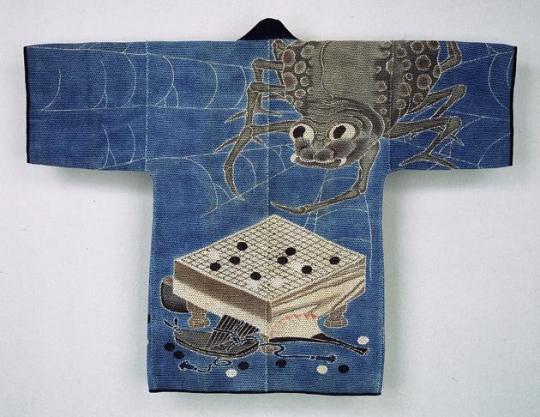
Japanese hikeshibanten jacket depicting spider and go board, 19th Century, Seattle Art Museum
4K notes
·
View notes
Text
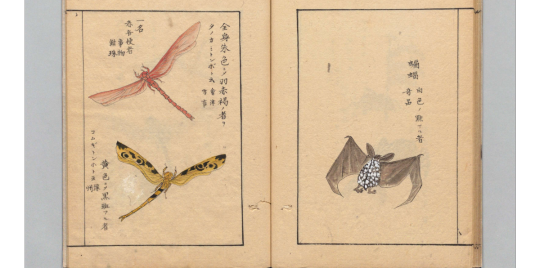

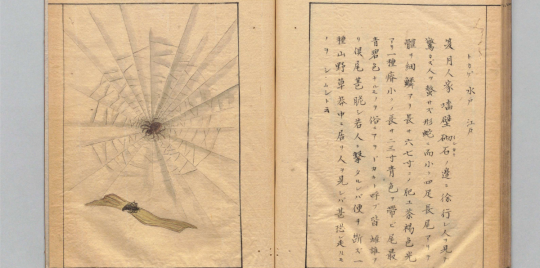
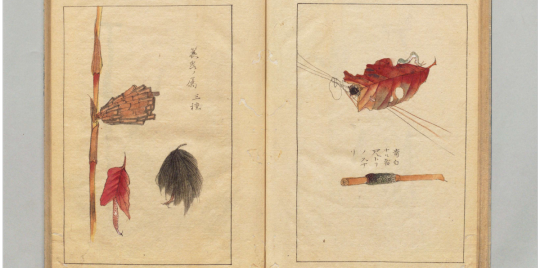
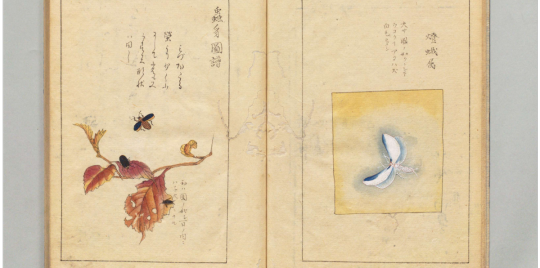
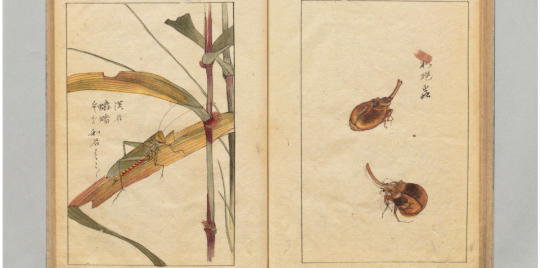
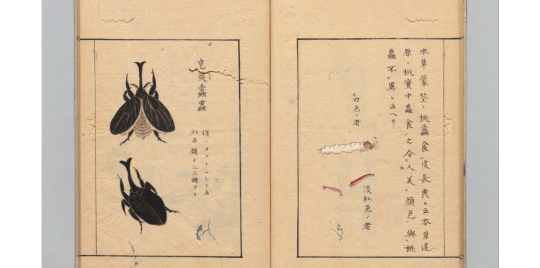


[虫豸図譜 - Chuuchizufu] Edo period illustrated book in four volumes (1 /2 /3 /4) depicting all kinds of tiny creatures, from crickets, beetles, centipedes and moths, to salamanders, frogs, snails and bats.
#japan#art#edo period#mushi#insect#bug#autumn in japan#salamander#snail#bat#cricket#beetle#spider#dragonfly
455 notes
·
View notes
Text
The Great Wave — Hokusai










Another non-requested set 💗 I really like doing these sets based on famous art lately, I hope it’s not too repetitive if I make it a little collection.
Also in this collection: Starry Night and Irises
• More from the Famous Art Collection •
#the great wave#the great wave off kanagawa#Hokusai#theme: art#theme: fish#theme: water#theme: ocean#art and media#ukiyo-e art#ukiyoe#edo period#ink on wood#woodblock print#games media and fandoms masterlist#color: multi pattern#color: black#color: blue#color: navy blue#color: yellow#color: white#theme: Japanese art#dividers#post dividers#graphic design#color: tan
635 notes
·
View notes
Text
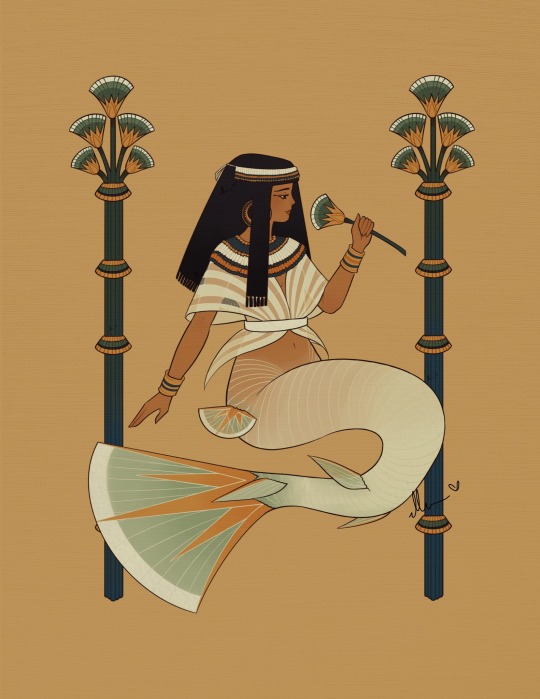


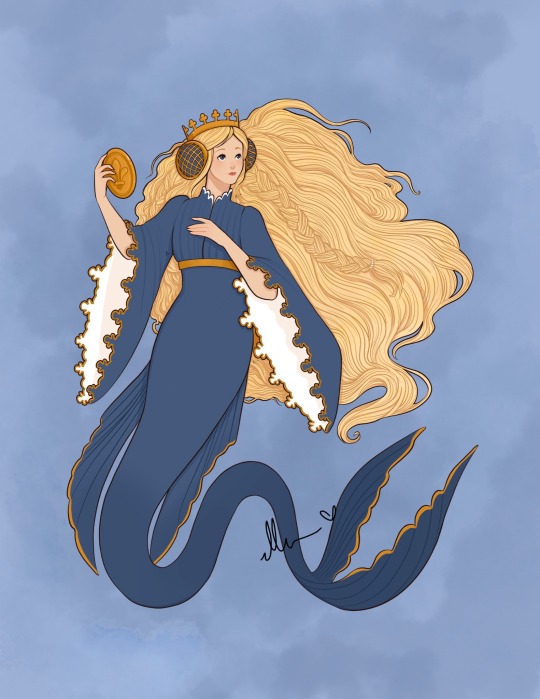
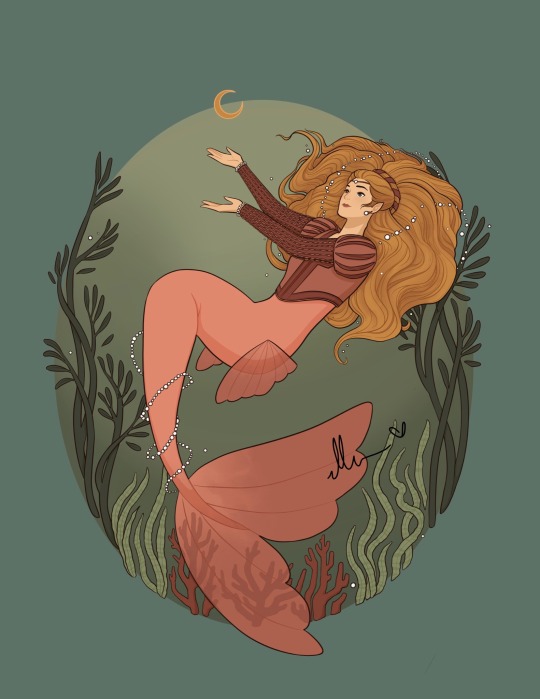
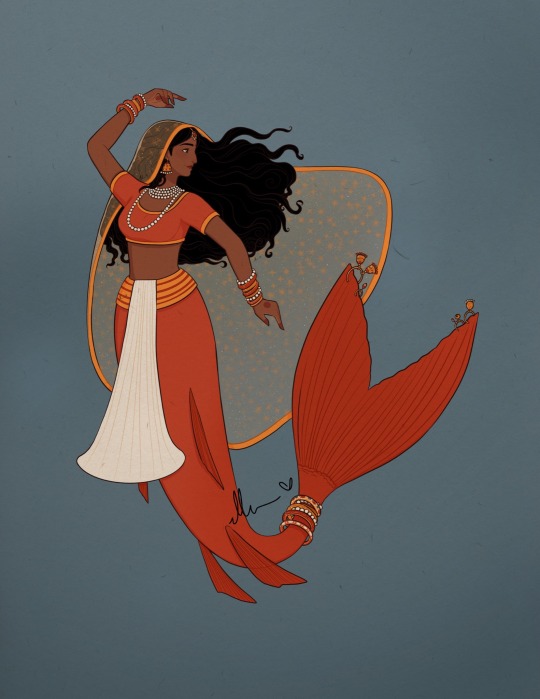
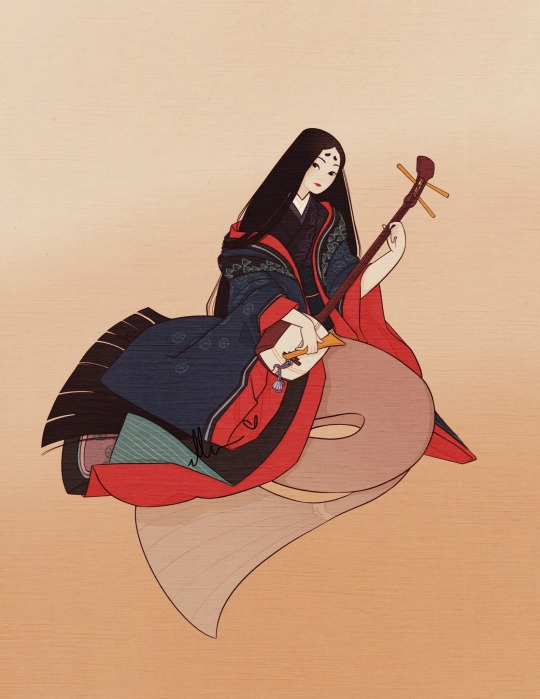

All the Historical Mermay’s together!
I had a lot of fun with this mermay prompt list by chloe.z.arts and they turned into a pretty cool collection of illustrations!
Prompt list by chloe.z.arts on instagram.
I am the artist! Do not post without permission & credit! Thank you! Come visit me over on: instagram.com/ellenartistic or tiktok: @ellenartistic
#historical mermay#mermay 2023#collection of mermaids#lnart#ellenart#historically inspired#historical fashion#it’s gonna be mermay#ancient egypt#ancient greece#tang dynasty#french medieval#italian renaissance#mughal empire#edo period#late victorian era
4K notes
·
View notes
Text

Utagawa Hiroshige (1797–1858) — The Fuji River in the Snow [woodblock print, 1841]
230 notes
·
View notes
Text

Sakura Haruno [Naruto] by TsuyaNoUchi
https://tsuyanouchi.etsy.com
#sakura#team 7 fanart#team 7#sakura haruno#naruto art#naruto#naruto fanart#naruto series#naruto shippuden#naruto au#sasuke uchiha#manga girl#ukiyoe#tsuyanouchi#edo period#japanese art#anime art#anime fanart#anime#manga#anime and manga#fanart
66 notes
·
View notes
Text
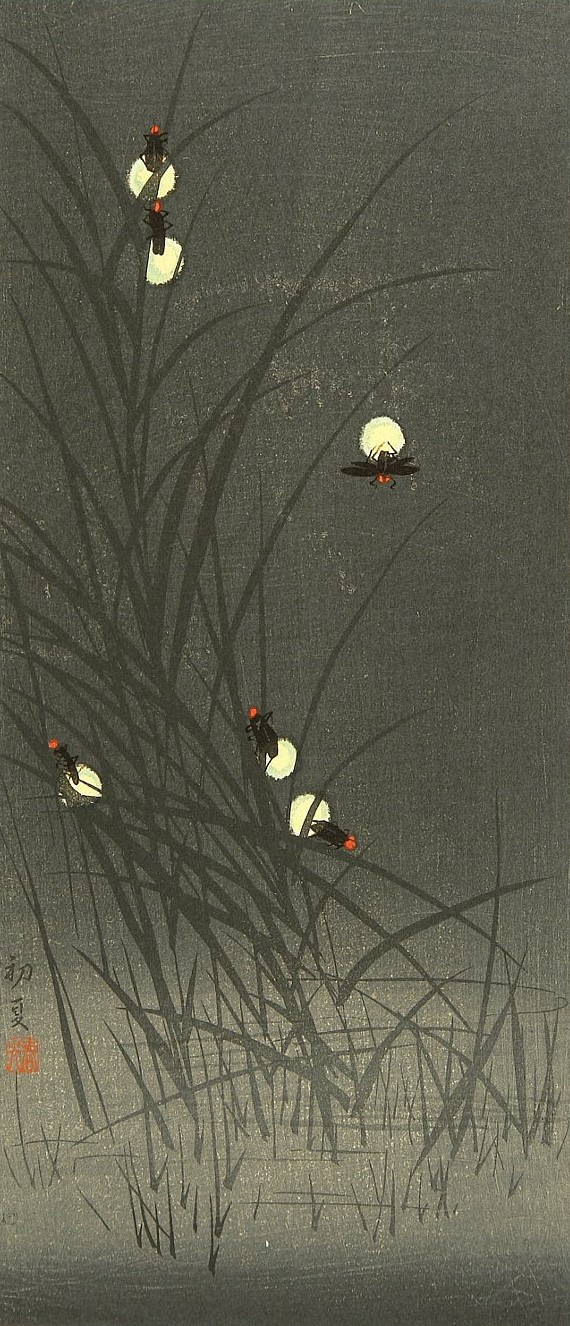
Fireflies in the Early Summer by Watanabe Shoka (19th Century)
#watanabe shoka#art#ukiyo-e#woodblock prints#fine art#19th century#19th century art#edo era#edo period#woodblock print#japanese art#japanese artist#nature art#fireflies#insects#summer#asian art#classic art
4K notes
·
View notes
Text

Black Bear Cub, Mori Shūhō, 1799
#art#art history#Asian art#Japan#Japanese art#East Asia#East Asian art#Mori Shūhō#painting#animals in art#bear#bears#black bear#winter scene#snow#ink and color on silk#Edo period#18th century art
3K notes
·
View notes
Text

Fan painting (1743) of white chrysanthemums upon a gold background by Ogata Kenzan (Japanese, 1663–1743).
Ink and colour on gold-leafed paper.
Image and text information courtesy The Met.
126 notes
·
View notes
Text

An impressive crab on p. 216 of Ms. Codex 3, three volumes of paintings or hand-colored sketches depicting mainly insects, fish and other marine life, birds and flowers. We don't know much about these books except that they were made in Japan, probably in the 19th century. If you know more, let us know!
🔗:
#manuscript#japan#japanese#edo period#drawing#painting#sketches#crab#animal#art history#book history#rare books#19th century
93 notes
·
View notes
Text
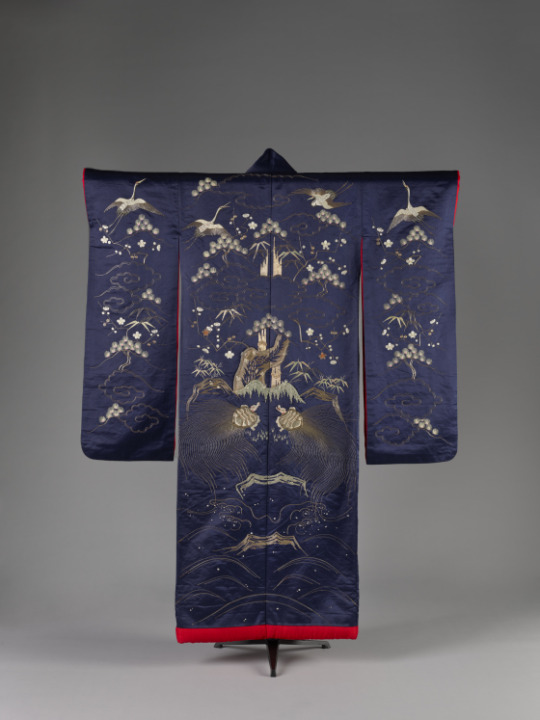
Wedding Kimono (Uchikake)
Chiba Prefecture, Japan
c.1850 (Edo Period)
Denver Art Museum
#wedding kimono#wedding#uchikake#fashion history#historical fashion#non western fashion#1850s#edo period#19th century#blue#silk#embroidery#denver art museum
748 notes
·
View notes